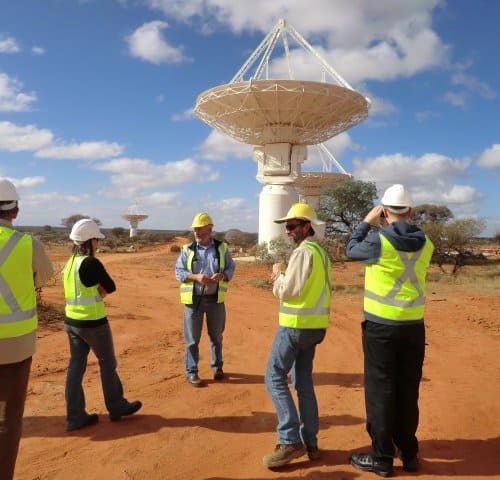
Antony Schinckel (centre right) and Barry Turner (centre left) with a finished ASKAP dish
By Matin Durrani in Boolardy, Australia
Our eight-seater plane landed safely on the sandy red airstrip at the remote Boolardy homestead deep inside Western Australia.
There to meet us was Barry Turner, site manager for the Murchison Radioastronomy Observatory, which is currently building two key astronomy facilities here in the Australian outback – the Murchsion Widefield Array and the Australian Square Kilometre Array Pathfinder (ASKAP) project.
ASKAP will, when complete next February, consist of 36 parabolic antennae, of which six are currently built. Apart from being 10 times more powerful than any existing radiotelescope in the world, ASKAP is also designed to show that Boolardy is a suitable location for Australia’s bid for the Square Kilometre Array – an even larger radiotelescope array that will, when complete, consist of some 3000 dishes.
ASKAP astronomers, including project director Antony Schinckel, naturally think their site is a worthy location for SKA, although they are at pains not to discuss or comment on the rival SKA bid from various nations in southern Africa.
After lunch and the obligatory safety briefing, which included warnings about possible venomous snakes, Schinckel drove us off by 4×4 van to the telescope site, which was bathed in pleasantly warm winter sunshine. (Summers, in contrast, can easily rocket above the 40 °C mark.)
On site were various constructions workers digging roads and levelling the site, but it was also interesting to see staff from the Chinese Electrical Technology Corporation, which is making the ASKAP dishes in China, shipping them to Australia and then building them here in the outback.
Their presence explains the Chinese menus in the Boolardy lunchroom, although quite what they make of Australia’s local delicacy – Vegemite – I am not sure.
The six completed dishes consist of a supporting structure that will house electroncs cables, topped by a steerable 12 m-diameter dish. So smooth are the dishes that they are no more than 0.6 mm out from a perfect parabolic shape.
Barry and Antony gave us a detailed run-down of the dishes, but with the Australian sun quickly setting, it was imperative that we did not hang around for too long so that we could fly away before sunset. By nightfall, the unlit landing strip would be so dark that taking off would be impossible.
And soon we were soaring above the ASKAP site for the 90-minute flight back to Perth. A fitting and illuminating end to my week-long trip to Australia.
Schinckel joined us on the flight. While my fellow European science journalists and I are to return to Europe, for Schinckel the work goes on. He and numerous other members of Australia’s SKA bid team are flying to Banff in Canada next week for a high-level discussion meeting where its bid – and that from southern Africa – are to be evaluated.
I get the feeling the Australian team is pretty confident of winning the SKA bid but, as I said earlier, they resolutely refuse to get drawn on the matter. We shall see who wins when the final decision is announced on 29 February next year.



